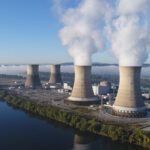Lutz Mez, Freie Universität Berlin, Berlin Centre for Caspian Region Studies, EXPERT COMMENTARY
The electrical power production sector accounts for about 28 percent of global anthropogenic carbon dioxide emissions and constitutes by far the largest source of greenhouse gas emissions. That is why supposedly carbon dioxide-free nuclear power plants have frequently been praised as a panacea for addressing climate change. However, in 2013 nuclear electricity contributed just 10.6 percent of global electricity generation, and because electricity represents only 18 percent of total global final energy consumption, the nuclear share is just 1.7 percent of global final energy consumption. Even if generation in nuclear power plants could be increased significantly, nuclear power will remain a marginal energy source. Therefore, the turnaround in energy systems has to prioritize energy efficiency and the use of renewable energy technologies and cogeneration plants, which do not cause any more carbon dioxide emissions than nuclear power plants.
From a systemic perspective, nuclear power plants are by no means free of carbon dioxide emissions. Today, they produce up to one third of the greenhouse gases that large modern gas power plants produce. Carbon dioxide emissions connected to production of nuclear energy amounts to (depending on where the uranium used in a reactor is mined and enriched) between 7 and 126 grams of carbon dioxide equivalent per kilowatt hour, according to an analysis by International Institute for Sustainability Analysis and Strategy co-founder Uwe Fritsche. For a typical nuclear power plant in Germany, the specific emission estimate of 28 grams has been calculated. An initial estimate of global carbon dioxide emissions through the generation of nuclear electricity in 2014 registered at about 110,000,000 tons of carbon dioxide equivalent—or roughly as much as the carbon dioxide emissions of a country like the Czech Republic. And this data does not even include the emissions caused by storage of nuclear waste.
In the coming decades, indirect carbon dioxide emissions from nuclear power plants will increase considerably, because high-grade resources of uranium are exhausted and much more fossil energy will have to be used to mine uranium. In view of this trend, nuclear power plants will no longer have an emissions advantage over modern gas-fired power plants, let alone in comparison to the advantages offered by increased energy efficiency or greater use of renewable energies.
Nuclear power plants may also contribute to climate change by emitting radioactive isotopes such as tritium or carbon 14 and the radioactive noble gas krypton 85. Krypton 85 is produced in nuclear power plants and released on a massive scale in the reprocessing of spent fuel. The concentration of krypton 85 in Earth's atmosphere has soared over the last few years as a result of nuclear fission, reaching a new record. Krypton 85 increases the natural, radiation-induced ionization of the air. Thus the electrical balance of the Earth's atmosphere changes, which poses a significant threat to weather patterns and climate. Even though krypton 85 is “one of the most toxic agents for climate,” according to German physicist and political figure Klaus Buchner, these emissions have not received any attention in international climate-protection negotiations down to the present.
As for the assertion that nuclear power is needed to promote climate protection, exactly the opposite would appear to be the case: Nuclear power plants must be closed down quickly to exert pressure on operators and the power plant industry to redouble efforts at innovation in the development of sustainable and socially compatible energy technologies and especially the use of smart energy services.
















